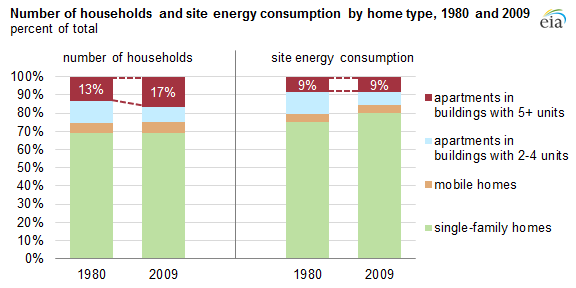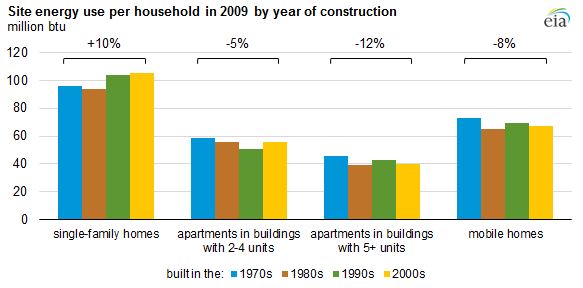
Apartments in buildings with 5 or more units use less energy than other home types

Republished: July 15, 2013: To correct an error in the text.
Thirty percent of new home starts in 2012 were in apartment buildings with five or more units, the highest percentage since 1986 and up sharply from 18% in 2009 and 2010, according to the U.S. Census Bureau. About 17% of households (19 million) lived in apartment buildings with five or more units in 2009, up from 13% (11 million) in 1980, but they only accounted for 9% of home energy use in both years. Over the same period, single-family homes maintained a steady share of total households, but their share of total home energy use went up. Apartments in smaller buildings have declined as a share of both households and energy use, and mobile homes remain a small segment of the residential sector.
Households in apartment buildings with five or more units use much less energy than the average for all households, and those in newer units use even less energy than those in older ones. As recent new construction joins the housing stock and older buildings fall out, energy use per household in large apartment buildings likely will continue to decline.
Households living in apartment buildings with five or more units use about half as much energy as other types of homes. Lower energy use in apartments can be partially explained by their smaller living space. Additionally, apartment units are bordered by other units or common areas on one or more sides and typically have fewer windows, limiting exposure to exterior temperatures.
Since 1980, per-household energy use in the larger apartment buildings has fallen by 38%, compared with declines between 15% and 32% for other home types. Energy use per household has decreased across all home types due to efficiency improvements in major equipment and appliances, despite increases in the average size of homes and the use of electronics. Much of this decline in home energy use is attributable to reduced consumption for space heating, as equipment has become more efficient, population has shifted to warmer climates, and many homes now have better insulation and windows. Apartments in buildings with five or more units have seen the largest change in per household energy use for space heating, which fell by 48% between1980 to 2009. Households in the larger apartment buildings in 1980 consumed almost as much energy for space heating (42 million Btu) as is now used for all purposes (a total of 46 million Btu for space heating, water heating, air conditioning, and appliances in 2009).
Another way to examine household energy data is to look at energy use for a single year across homes built at different times. Overall, new homes consume about as much energy as older ones, but trends differ by home type. Households living in new (2000s) single-family homes use more energy than those living in older homes. For all other home types, the reverse is true. When comparing newer (2000s) homes to those built in the 1970s, apartments in large buildings show the greatest decrease in per-household energy consumption. Households in large apartment buildings constructed in the 2000s consume 12% less energy than those built in the 1970s. Less energy is used by households in new apartments despite having more energy-consuming devices than older apartments—more air conditioning equipment, more major appliances like dishwashers and clothes washers and dryers, and more consumer electronics like computers and televisions.
The comparisons of energy use in this article are based on the amount of energy delivered to residences, and do not include energy losses in the generation of electricity that is used by households, which is part of the total amount of primary energy required to support site-level energy use.

Tags: consumption/demand, efficiency, residential